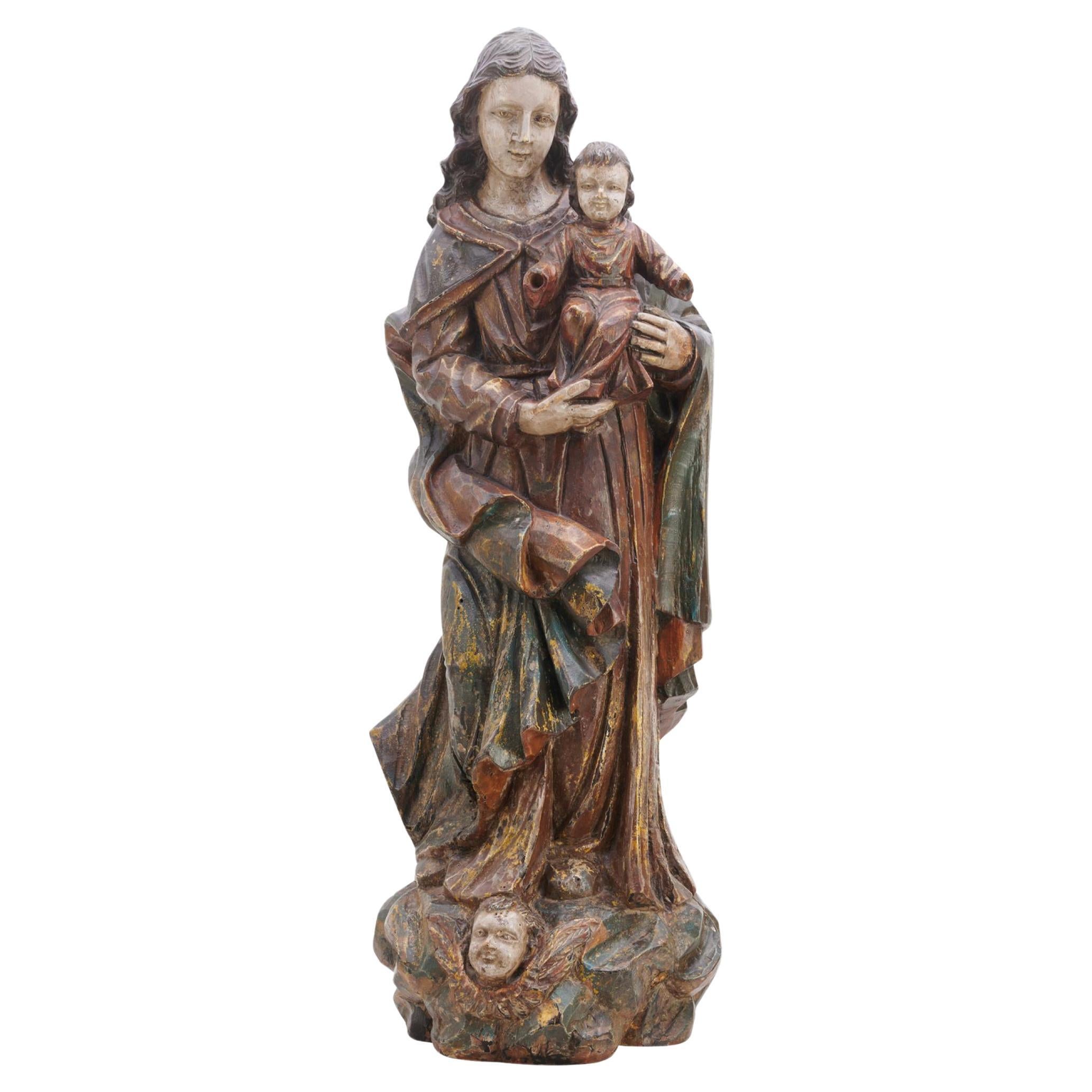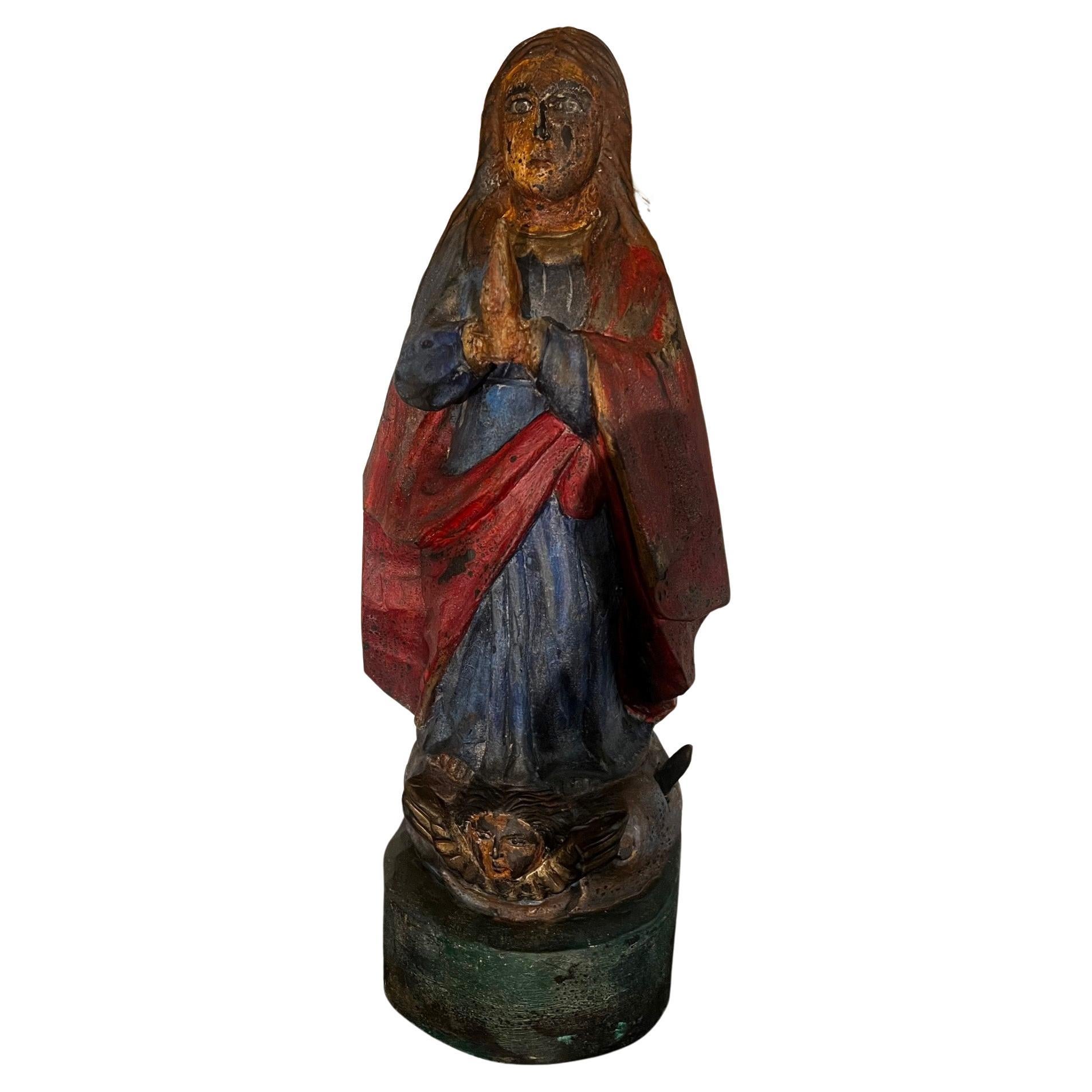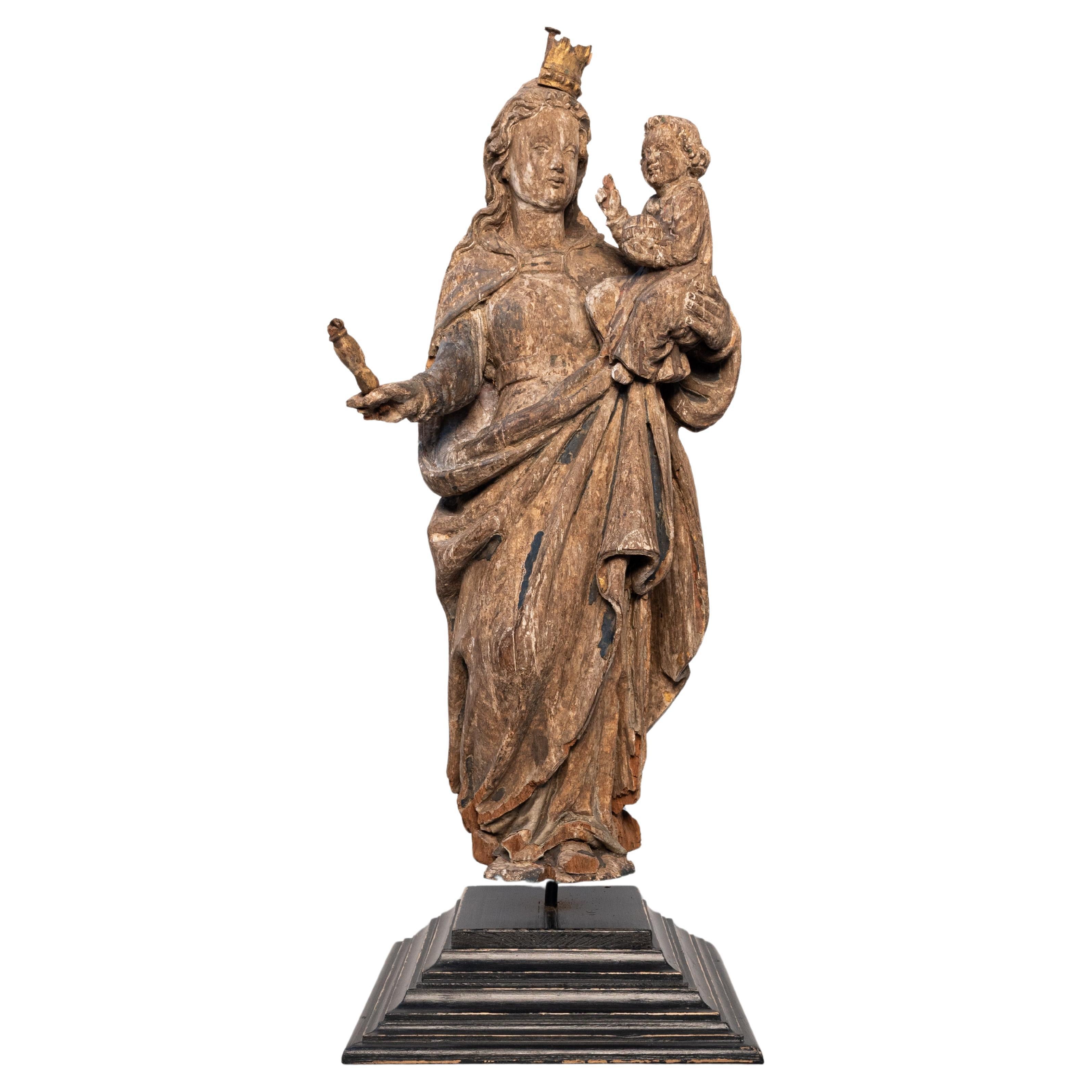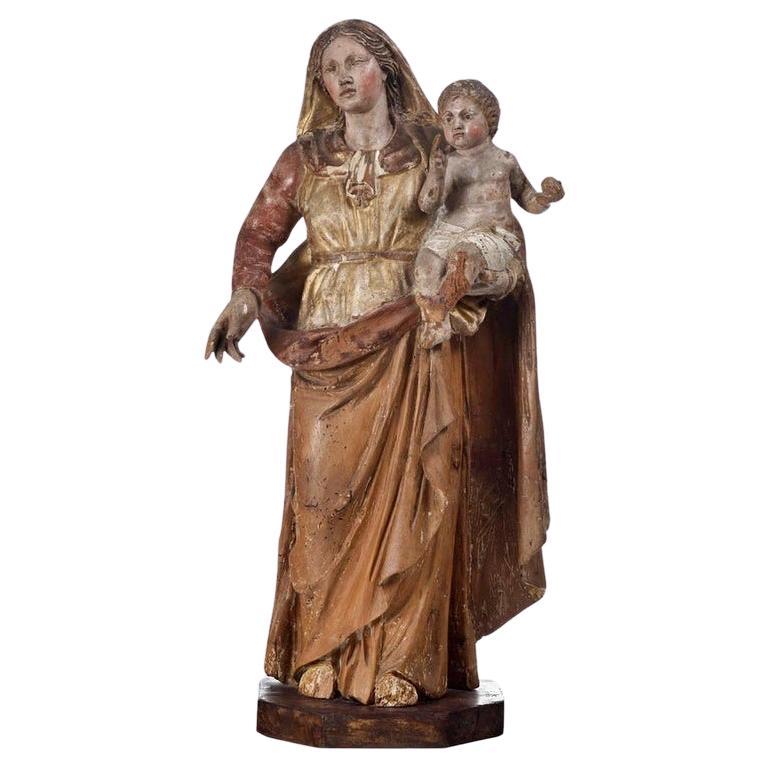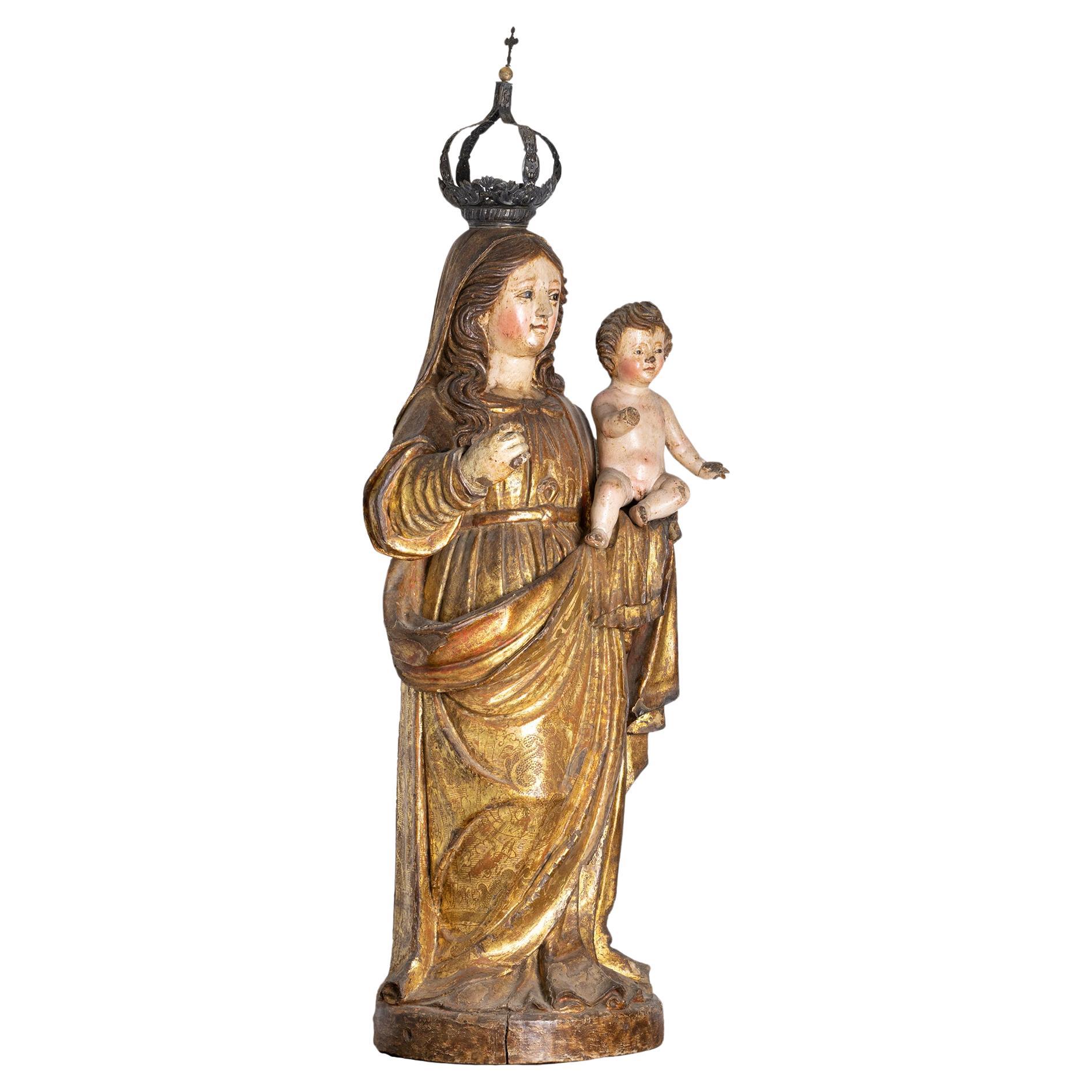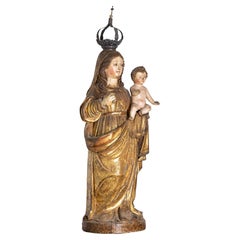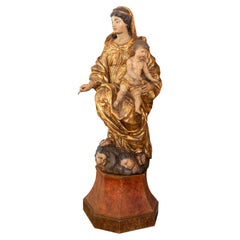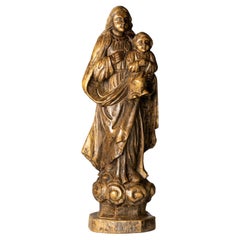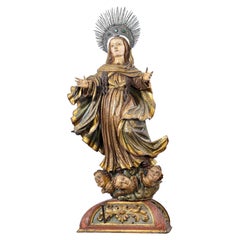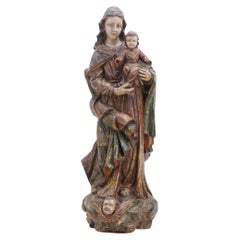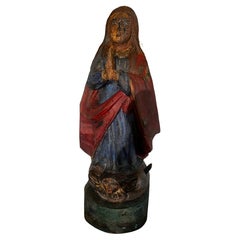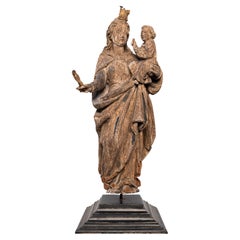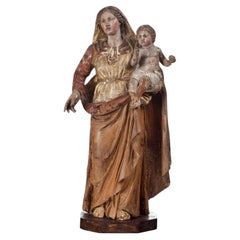Items Similar to Virgin of Mercy Statue, Religious Art, Baroque Style, 18th Century
Video Loading
Want more images or videos?
Request additional images or videos from the seller
1 of 9
Virgin of Mercy Statue, Religious Art, Baroque Style, 18th Century
$5,732.15
$7,165.1920% Off
£4,342.23
£5,427.7920% Off
€4,921.60
€6,15220% Off
CA$7,941.12
CA$9,926.4020% Off
A$8,906.49
A$11,133.1120% Off
CHF 4,664.19
CHF 5,830.2420% Off
MX$108,222.56
MX$135,278.2020% Off
NOK 59,227.42
NOK 74,034.2820% Off
SEK 56,151.77
SEK 70,189.7120% Off
DKK 37,471.91
DKK 46,839.8920% Off
About the Item
An 18th Century figure of the Pietà or the Virgin of Mercy, carved in polychrome wood.
Our Lady appears seated on the throne with her head covered by a mantle, supporting the inert body of Christ with her left arm.
The face of the Holy Mother is carved in pain, weeping the body of the Son in Holy Silence, despairing Love.
A remarkable sculptural Portuguese work, influenced by the Flemish School, with a silver halo.
Take into account that the colors on the items may vary depending on the type of lighting and the type of screen from which you see the images.
- Dimensions:Height: 14.57 in (37 cm)Width: 9.45 in (24 cm)Depth: 7.88 in (20 cm)
- Style:Baroque (Of the Period)
- Materials and Techniques:
- Place of Origin:
- Period:
- Date of Manufacture:18th Century
- Condition:Wear consistent with age and use. Minor fading.
- Seller Location:Lisbon, PT
- Reference Number:Seller: 301stDibs: LU9157243872652
About the Seller
5.0
Vetted Professional Seller
Every seller passes strict standards for authenticity and reliability
Established in 2023
1stDibs seller since 2023
5 sales on 1stDibs
Typical response time: <1 hour
- ShippingRetrieving quote...Shipping from: Lisbon, Portugal
- Return Policy
Authenticity Guarantee
In the unlikely event there’s an issue with an item’s authenticity, contact us within 1 year for a full refund. DetailsMoney-Back Guarantee
If your item is not as described, is damaged in transit, or does not arrive, contact us within 7 days for a full refund. Details24-Hour Cancellation
You have a 24-hour grace period in which to reconsider your purchase, with no questions asked.Vetted Professional Sellers
Our world-class sellers must adhere to strict standards for service and quality, maintaining the integrity of our listings.Price-Match Guarantee
If you find that a seller listed the same item for a lower price elsewhere, we’ll match it.Trusted Global Delivery
Our best-in-class carrier network provides specialized shipping options worldwide, including custom delivery.More From This Seller
View AllPortuguese Baroque Madonna and Child Sculpture, 17th Century
Located in Lisbon, PT
This late 17th-century Portuguese Baroque sculpture in polychromed wood depicts the Madonna holding the Christ Child, carved with exquisite detail and spiritual grace.
The Virgin is...
Category
Antique Late 17th Century Portuguese Baroque Figurative Sculptures
Materials
Gold Leaf
$17,197 Sale Price
20% Off
Italian Baroque Religious Madonna and Child Sculpture, 18th Century
Located in Lisbon, PT
An 18th-century Italian sculpture of a draped Madonna, masterfully carved in polychrome and gilded wood.
The Virgin, gracefully veiled, holding the infant Jesus on her lap with a st...
Category
Antique 18th Century Italian Baroque Figurative Sculptures
Materials
Gold Leaf
$22,930 Sale Price
32% Off
Statue of Our Lady and Child, Religious Sculpture, 20th Century
Located in Lisbon, PT
This captivating 20th-century statue depicts Our Lady holding the Child Jesus, crafted from warm wood with a timeless elegance.
Standing at 84 cm tall, the statue exudes a sense of ...
Category
20th Century Portuguese Baroque Figurative Sculptures
Materials
Wood
$2,866 Sale Price
20% Off
Immaculate Conception Religious Sculpture, Baroque, 18th Century
Located in Lisbon, PT
An exceptional 18th-century Spanish Baroque sculpture of the Immaculate Conception, carved in chestnut wood and richly polychromed and crowned.
The sculpture retains its vibrant pi...
Category
Antique 18th Century Spanish Baroque Figurative Sculptures
Materials
Metal, Brass, Gold Leaf
$40,946 Sale Price
20% Off
Portuguese Baroque Sculpture of Jesus, Religious Art, 18th Century
Located in Lisbon, PT
An 18th-century Portuguese Baroque sculpture portraying the Infant Jesus, hand-carved in polychrome wood. This religious piece dates between 1770 and 1790, preserves its serene blue ...
Category
Antique 18th Century Portuguese Baroque Religious Items
Materials
Silver
$5,446 Sale Price
20% Off
Jesus Salvator Mundi Sculpture, Flemish Religious Art, 17th Century
Located in Lisbon, PT
This masterfully carved 17th-century Flemish sculpture presents Jesus Christ as the “Salvator Mundi” — Savior of the World — a powerful icon of devotion and divine kingship.
Sculpte...
Category
Antique Late 17th Century Belgian Renaissance Figurative Sculptures
Materials
Wood, Chestnut
$5,302 Sale Price
20% Off
You May Also Like
A Carved Polychrome Painted Figure of the Virgin and Christ, 18th Century
Located in ARMADALE, VIC
A Carved and Polychrome-Painted Group of the Virgin and Christ, 18th Century
The modelled standing in robes holding the Christ child, on a rockwork base with a seraphim mask to the ...
Category
Antique 18th Century French Baroque Figurative Sculptures
Materials
Hardwood
18th Century Italian Carved Wood Polychrome Virgin Mary Sculpture
Located in Doha, QA
This is an outstanding Italian 18th century carved wood polychromed sculpture of Virgin Mary. The Sculpture is hand painted with some remains of a gold gilt in few places and originated until lately in a private Villa in Tuscany (Italy). The colors are typical red, blue and green are spectacular on this large figure. The Virgin's hands are joined together in a prayer, while standing on a pedestal on the both sides of which are devil's horns (bottom left side horn missing ) symbolising Holly Mary defeating the Evil, protected by the Holly Ghost and an Angel. A story tells the pose of the Virgin Mary sculpture...
Category
Antique 18th Century Italian Baroque Figurative Sculptures
Materials
Wood, Pine
European 16th Century Hand Carved Wooden Virgin Mary Polychrome Statue
Located in Oostende, BE
This 16th century hand-carved wooden Virgin Mary polychrome statue comes from a church in Sint-Niklaas, Belgium (Europe), and was bought directly fr...
Category
Antique 16th Century Belgian Gothic Religious Items
Materials
Walnut
Wooden Madonna with Child Baroque Art Italy 17th Century with Export Certificate
Located in Madrid, ES
A Wooden Madonna with child Baroque art, Southern Italy, 17th century.
Measure: H: 71cm
Good condition for the time.
With Export Certificate to USA.
Category
Antique Early 17th Century Italian Baroque Figurative Sculptures
Materials
Wood
$4,567 Sale Price
20% Off
18th Century Spanish Polychrome Wood Sculpture of the Immaculate Virgin
Located in Madrid, ES
18th Century Spanish Polychrome Wood Sculpture of the Immaculate Virgin
A captivating 18th-century Spanish School sculpture of the Immaculate Virgin, masterfully hand-carved in poly...
Category
Antique 18th Century Spanish Baroque Religious Items
Materials
Wood
Polychrome carved wood Virgin and Child from the 15th Century
Located in Saint-Ouen, FR
POLYCHROME CARVED WOOD VIRGIN AND CHILD FROM THE 15TH CENTURY
ORIGIN: SOUTH GERMANY, SWABIA, NUREMBERG REGION
PERIOD: 15th CENTURY
Height: 94,6cm
Width : 28 cm
Depth : 18 cm
Lime wood
Original Polychromy
Good state of conservation
From 1430 onwards, sculpture underwent a profound stylistic renewal which continued until 1530, the so-called late Gothic period. In the Germanic countries, original sculptures flourished in an expressive and sensitive vein.
This renewal was inspired by the art of Nicholas of Leiden, who was active in Strasbourg in the 1460's. His style broke with the refined and delicate art of the international Gothic style in force throughout Europe around 1400. The figures became more authentic and realistic. The bodies became denser. Clothes are animated by deep, broken folds, the fabrics are heavy and have a great decorative value. In addition, the polychromy is intended to be illusionistic. The painting makes it possible to restore the texture of the materials, the richness of the textiles and the natural skin tone of the characters.
The dissemination of images through engraving and the great mobility of the artists led to the success of this style, which conquered the Upper Rhine, Swabian, Tyrolean and Franconian regions, contributing to the formation of a common stylistic identity in these regions. The economic boom in the flourishing German cities was conducive to the development of original production. Attracted by this prosperity, numerous workshops were set up in order to meet the orders of religious communities, the Church and the laity, including a clientele of middle-class rockers.
This precious Virgin and Child is depicted standing on a crescent moon, her head encircled by a crown of tall flowers. Her long wavy hair spreads over her shoulders, framing her beautiful oval face. Under fine eyebrows drawn with a brushstroke, her almond-shaped, slightly drooping eyes look at the Child with infinite softness. She is dressed in a long red dress with a rounded neckline, belted under the chest. The heavy fabric of her dress spreads out in broken folds at her feet. On her shoulders she wears a golden cloak. The drapery has deep folds. She holds out her right hand while she holds the Christ Child with her left.
Christ, with his well-defined hair, is naked. His cheeks are highlighted with red, he holds an apple in his left hand and with the other hand makes a sign of blessing towards the faithful.
Virgins with Child on a crescent moon were very popular in the second half of the 15th century, especially as the central subject of altarpieces in southern Germany and Austria. The crescent moon on which Mary is standing is reminiscent of the Woman of the Apocalypse. Often equated with the Virgin Mary.
This episode is taken from the Book of Revelation (12:1-6)
1 Then a great sign appeared in heaven: a woman clothed with the sun, with the moon under her feet and a crown of twelve stars on her head. ; 2 She was pregnant, and she cried out because she was in labor, in pain from giving birth. ; 3 Then another sign appeared in heaven: it was a great fiery red dragon, with seven heads and ten horns, and seven royal crowns on his heads. ; 4 His tail swept down a third of heaven's stars and threw them to the earth. The dragon stood in front of the woman who was about to give birth so that when she gave birth, he might devour her child. ; 5 She gave birth to a son, a male child who is to rule all the nations with an iron rod. Her child was snatched up to God and his throne. ; 6 Then the woman fled into the desert, where God has prepared a place for her. There she will be taken care of for one thousand two hundred sixty days.
Some theologians see in this woman a reference to the Virgin Mary and in the child, Jesus.
This remarkable work is a very fine example of sculpture from Swabian workshops in the last decades of the 15th century. It presents all the characteristic stylistic elements: a highly girdled silhouette, an abundant drapery with angular folds, but also a great physical presence accentuated by the polychromy that restores the anatomical details. This group is made of a wooden log. The deep folds of the drapery highlight the movement of the Virgin holding the child.
Bibliography :
Sophie Guillot de Suduiraut, Dévotion et Séduction, Sculptures souabes des musées de France, vers 1460-1530, Paris musée du Louvre-Éditions somogy, 2015
“Revelation 12 - Common English Bible...
Category
Antique 15th Century and Earlier German Gothic Figurative Sculptures
Materials
Wood
